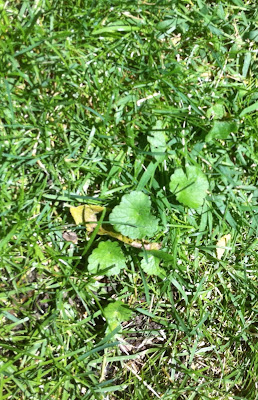 |
| Common blue violet |
Ground ivy, also known as creeping Charlie, Glechoma hederacea, offers lush dark green leaves that are rounded with toothed edges and small funnel-shaped purplish-blue flowers in the spring. This perennial belongs to the mint family and has square stems and a pungent odor when the leaves are crushed. Ground ivy and wild violets can sometimes be confused when flowers are not present.
Both plants spread via seed from blossoms, branching rhizomes, and creeping roots. With so many options to expand their range, it’s easy to see how they do so very easily. These plants will simply spread out of your landscape beds and into your lawn. Removal of them is a little more complicated. Hand-pulling often just results in a lot of time and effort and broken off plants as they have extensive root systems. Herbicides are usually recommended.
 |
| Ground Ivy in turf |
If violets or ground ivy are in your lawn, you’ll need to use a broad-leaved herbicide only. This type of herbicide will not harm your established lawn but can harm neighboring desired plants if the spray drifts. Caution is highly recommended by using herbicides on very calm days and following all label directions.
A herbicide containing triclopyr, 2,4-D, MCPP, dicamba, or sulfentrazone is recommended for success in control, with triclopyr showing the best results. The best time to apply this spray on perennial weeds, such as violets and ground ivy, is September to early October. Plants are storing energy reserves in their roots and stems for winter and the herbicide will be able to reach all parts of the plant via the food reserves. You might not see immediate results but should see some impact in the spring. Multiple treatments may be necessary. If you only have a few violets in your lawn spot-treat those areas, instead of applying herbicides to your whole lawn.
A healthy lawn is also the best defense against these and other weeds. Proper mowing, fertilizing, watering, and aeration practices will provide you with the greatest success in conquering weeds. The best defense I’ve discovered though is a healthy acceptance of a not so perfect lawn. Consider lawn violets or ground ivy as a pretty addition and if you don’t spray them with herbicides you can incorporate them into your next salad. I am amazed at the number of things you can do with these plants from foods to vinegars to cosmetics. There’s always a bright side right?
common violet photo by sierrapotomac.org
common violet photo by sierrapotomac.org



